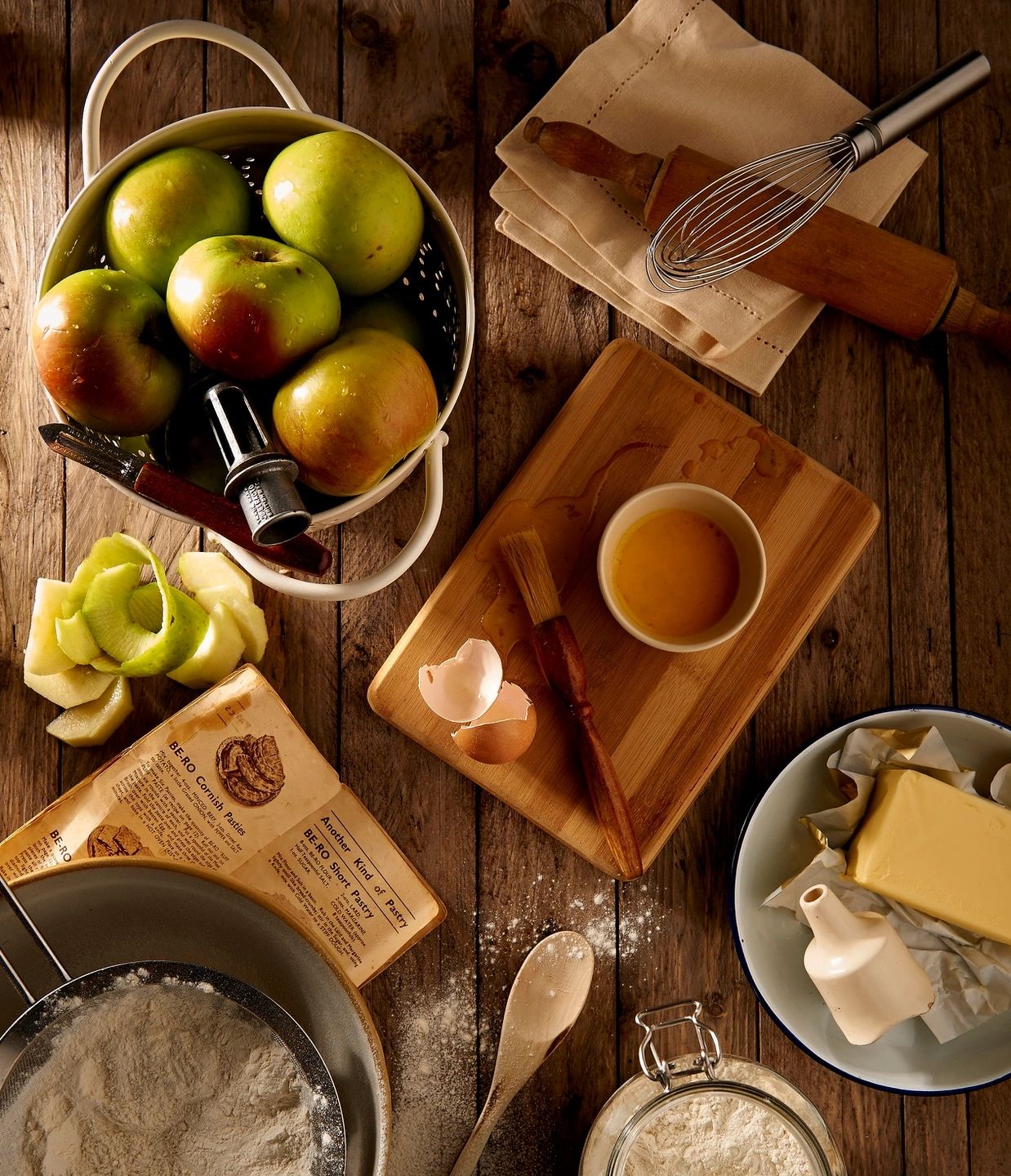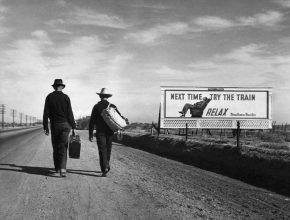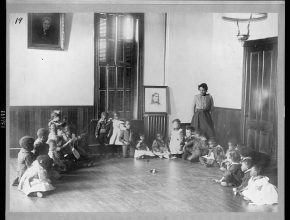I am a professional dirt bag and failed Independent Fundamentalist Baptist who grew up in the oil fields of west Texas. I am also poet, writer, educator, translator, and activist. My work has been published in English and Spanish and has appeared in ZYZZYVA, Catapult, Cimarron Review, Willow Springs, Guernica, Aster(ix) and Kweli, among others. I earned an MFA from the University of Texas El Paso’s Bilingual Creative Writing Program and taught in a a variety of settings across the U.S. and Latin America.
Home Tastes Like Junk
She lit cigarette on the stove. While it smoldered in her mouth, she pierced a hot dog with a fork and twirled it around in the gas flame. Grease dripped into the element and sparked as she turned her head and shouted, “Nice to meet you, but I’m leaving for work in five minutes.” This, my father’s first introduction to my grandmother, is what enters my mind when about people wax poetic about “Grandma’s home cooking.” When people talk about food culture in the United States, they often conjure up images of recipe books passed down from generation to generation, Norman Rockwell, and glossy holiday dishes. This food culture is unfamiliar to me. Growing up, my mother’s idea of cooking was Hamburger Helper and microwaving canned vegetables. My food related warm fuzzies come when I remember chugging Mountain Dew Code Red while sucking Flaming Hot Cheetos with my friends in middle school and I know I’m not alone.
In the rural West Texas community where I grew up, food was and still is a matter of “personal freedom.” Healthy meant an iceberg salad drowning in Ranch dressing. People shoveled down chicken fried steak while guffawing about “stuck-up liberals” and their “rabbit food.” Michelle Obama, became head of the “food police” and Sarah Palin became a national hero for sucking down a Big Gulp at the Republican National Convention. It’s hard to come back to where I grew up and not feel like an outsider—like one of those “big city people” trying to run everybody’s lives—even if for me that only means exercising my personal choices in public. I feel bad calling out my family and community because I used to laugh too. I was indignant when the soda and snack machines were taken out of my high school to comply with a recently passed state law. What do I do now when food choices are only one of the things about my life that make people raise an eyebrow and ask, “So, you think you’re better than us?” Should I just keep my mouth shut since my new reality doesn’t involve chugging another Monster and working another double shift? I feel stuck between indignation and resignation because I remember feeling judged too.
In college how a friend of mine, an international student, complained about how much she disliked the host family she stayed with her first time in the U.S. as a high school exchange student, “They were a bunch of rednecks,” she laughed. “They’d put a can of beans in the microwave and say they cooked.” Rednecks. Canned beans in the microwave. Could she tell that used to be me when she talked to me now? Overweight as a child, teen and young adult, I hadn’t considered my experiences with food as a classed issue, but as a personal failure. I had no willpower. The bottomless pit inside me that could never be filled. But by the time I was a young adult, so far from rural West Texas both geographically and ideologically it might as well have been outer space, there was no denying it—to the solidly and perpetually middle classed, as well as to the well-heeled purveyors of food culture, we were nothing but a bunch of rednecks microwaving canned green beans in butter and calling it cooking. Friends talk about how their families limited the consumption of sweets. “A whole candy bar? There’s no way I would have been allowed to eat that!” They scoff. It feels as foreign to me as when they crouch in front of their children and said, “Use your words. Don’t hit,” instead of, “Knock the crap out of that kid. He’ll never leave you alone unless you fight back.”
I was never a good fighter, but I could put away the candy bars. On Saturdays when we would visit my grandmother at her public housing complex in Midland, Texas, my brother and I would trudge across an empty lot sprouting plastic bags to the dollar store. She gave us each five dollars and told us to buy whatever we wanted. We stuffed plastic bags with two for a dollar candy bars that we ate while my grandmother rolled her own cigarettes on a lap-sized collapsible metal TV tray. For our birthdays one year she bought us each our own tray. Puffalumps for me and Power Rangers for my brother. We crunched King Vitamin cereal, the generic Captain Crunch, on the couch while my uncle sat on the floor inches from the TV fingering rosary beads as shots of ceiling frescoes from the Vatican punctuated the Hail Marys and Our Fathers scrolling across the screen. We reveled in the abundance of the kaleidoscope of cheap sugar spread out in front of us.
After I left my hometown on a scholarship, I sailed through college on macaroni and Hot Pockets, and save my friend the international student, most everyone else ate like me. At the afterschool program where I worked we boiled hot dogs by the cauldron and served up red Flavor-Aid until we got a grant and started serving up chicken salad flaked with almonds and split grapes on whole wheat toast. Either way, I took home what the kids didn’t eat or bring home to their parents. It was only when I started rubbing elbows with professionals that I started noticing differences in our approaches to food. The elaborate layers of my boss’ lunchtime salad assembled from multiple containers. The tiny portions at a $15 brunch. The chuckling that anything bought at a gas station could be considered food.
Once, on the way to social gathering in grad school, I grabbed a bag of chips from the Circle K, so I wouldn’t show up empty handed. I was unfamiliar with the concept of a host providing all the food at a gathering. That people had dinner parties and not potlucks. I was the only one who brought food and everyone else stacked wine or craft brew on the kitchen island. Where I grew up, nobody drank unless it was in secret or in a shop busting back Natty Lights while watching the UFC fight. The hosts silently poured the opened bag I had set on the table into a bowl and then exclaimed, “This flavor is really interesting and different. What is it?” Had they really never eaten barbeque flavored chips before or were they passive-aggressively judging my potluck offering as substandard? I nodded and reached for a tiny hors d’oeuvres plate. I piled that artisanal shit up high and ate every bite.
I looked around the dinner party kitchen with its stainless steel appliances and granite countertops and thought about the obsessive attention my mother paid to placing forks under paper napkins and the plastic flowers in the center of my childhood table. I didn’t realize it then, I’ve come to realize that my mother and others in my community had been frantically trying to break into the middle class. I remember my friend’s mother swatting our hands with a dish towel when we tried to put steaming pots on the table. I felt embarrassed by the training materials we used at work to discuss cultural differences between classes that listed serving food from the stove and eating in front of the TV as a “lower class activity.” No wonder our mothers, raised in poverty, made such a show of serving food from bowls on a set table. We were always trying to imitate an idea of what middle class people did now that my parents had catapulted themselves there by their bootstraps, but we never could get it quite right. The rules were always changing and by the time we thought ourselves socially mobile by the fact that we could eat packaged foods and carry out fast food several times a week. Professionals who had been middle class for more than a generation had switched to whole foods, cooked from scratch by a nebulous someone if not prepared by themselves from some subscription service they heard advertised nonstop during their favorite podcast. I was just now getting the memo. My family and community hadn’t “kept up.”
As a young, non-profit worker in the mid-2000s, my encounter with conversations concerning agriculture, the environment, wellness, and justice seemed inevitable. I watched Food Inc., worked through Barbara Kingsolver’s seasonal eating strategies in Animal, Vegetable, Miracle. I read Michael Pollan’s food books and agreed with most of what he argued about food systems and cooking on principle, but I felt unsettled. Where were the armies of slaughterhouse and food service employees or agricultural workers? What were their experiences like and what were they eating? There was too much emphasis on introspection and presentation without enough attention to the wallet or to the dynamics surrounding race and gender. I grew tired of images of some 1950s bougie housewife serving her children out of glazed crockery. On one of the rare occasions that my mother sat down for dinner as a child, my grandmother’s boyfriend stabbed her in the arm with a fork. This is the story I received nonchalantly when I asked about the pink prong shaped skin that rose from her shoulder blade. No thanks, midcentury nostalgia doesn’t run in my family. I rolled my eyes at his description deer hunting in the New York Times Magazine. I couldn’t handle the audacity of him calling himself a “modern hunter-gatherer” while in the same breath talking about his fancy chef friends. Polite society used to think we were barbarians for knowing how to field dress a deer. Everyone used to make fun of rednecks for hunting and having chickens in their yards and now all the sudden it’s cool to shoot your own venison and buy a chicken coop for your suburban backyard? God forbid you ever live in a trailer, but tiny houses are the next big thing in sustainable living. Poor people and people of color have been doing that shit for centuries without any credit and now on top of everything they else get a heaping serving of judgment for position they occupy in the food system.
Working on a sustainable farm is the closest I’ve been able to afford fresh, local produce, and pasture raised meats. Despite my forays into farmer’s markets as a vendor for a poultry and egg farm, when I go shopping I know where I feel most comfortable. I am Wal-Mart, not Target, and I am most definitely not Whole Foods. I know the facts about Monsanto, CAFOs, and big oil, but they pay the bills where I live. “I thank God for the oilfield every day, Missy,” a friend’s mother stabbed into my chest when I was back visiting. “Smells like money,” a friend’s father remarked as we drove past a feedlot. Despite where I try to squeeze in on the socio-economic scale and attempt to shake off my market based identity, the way I’ve been marked by corporations feels accurate. I try to fight against my impulse to view fast casual chains as aspirational. I try to channel old food ways, but I know that can also be bogus too, yearning for something that never fully existed, conveniently omitting that they also came with malnutrition and starvation. Sometimes I think people forget that one of the most common ingredients in ancestral foods for most people was nothing. Boxed and canned food arrived around the same time as the Polio vaccine and the washing machines. No wonder my ancestors greeted them with open arms, but now what?
Though I say I want to eat more healthfully and ethically, I often seek out those feelings that are familiar to me. The first dent in a softened pint while sitting on the stairs of our apartment complex on a Friday night. Neon candies rattling against a cardboard box. The fluorescent lights of the corner store flickering on payday as I waited in line behind men in coveralls splattered with paint, oil and dirt holding tall boys. My class-consciousness induced rage drives me to the snack aisle, my cultural identity somehow wrapped up in a deep fried hydrogenated bomb filled with corn syrup subsidies. I have a garden if we’re living somewhere with a patch of dirt. Otherwise I halfheartedly try to regrow garlic and lettuce in coffee containers under a hanging lamp. When we’re living on the road we eat gas station burritos. The injustice of new and old food systems makes me feel nauseous. Gentrification on one end and the glossy candy kaleidoscope on the other. My food culture reflects my journey and sometimes I can’t help longing for factory-farmed mechanically separated and artificially flavored food product. Sometimes I just want to eat a can of Vienna Sausages, ramen and some Fun Dip not because I don’t know “better,” but because it tastes like home.







